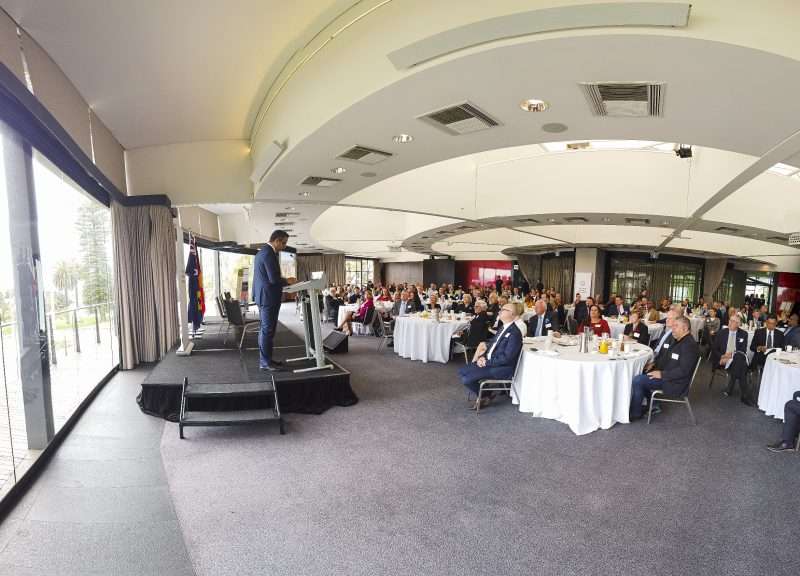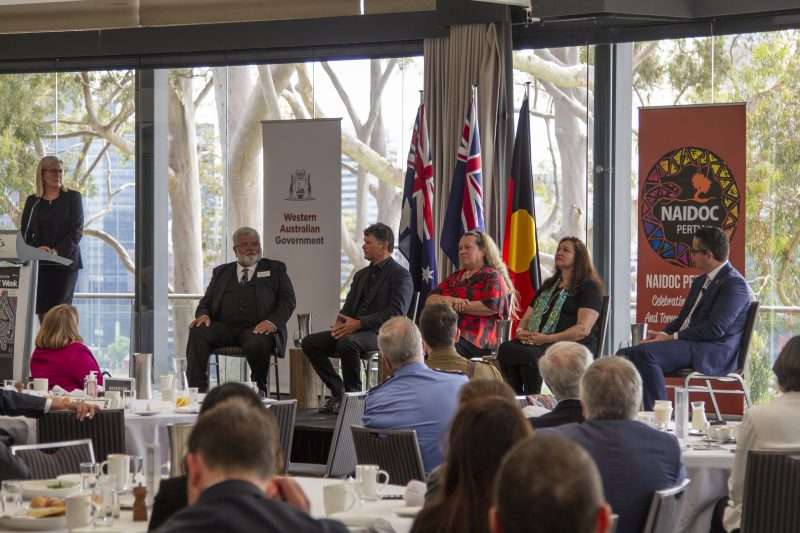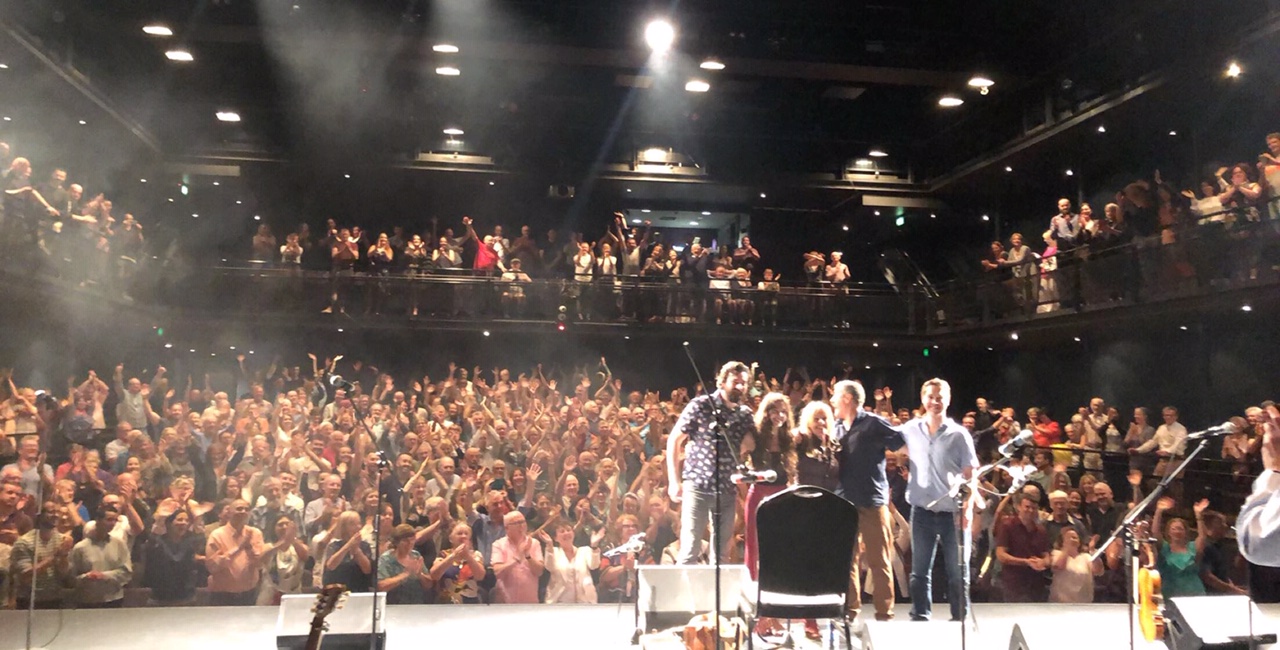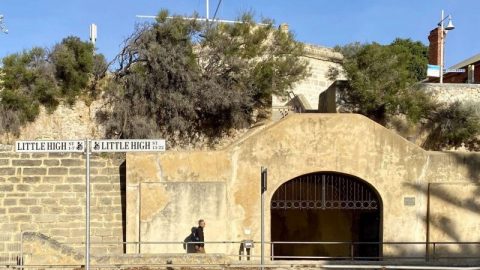The Hon Ben Wyatt is the Minister for Aboriginal Affairs in the Western Australian Government. On 11 November 2020, at Fraser’s Restaurant, Kings Park, Perth, Western Australia, Mr Wyatt delivered the 2020 NAIDOC Week Speech.

Every now and then a speech, like Mr Wyatt’s, comes along, that we at the Shipping News believe deserves a wider audience – as we did just a year ago when we published the The Vincent Lingiari Memorial Lecture of the Federal Minister for Indigenous Australians, The Hon Ken Wyatt.
Here’s Mr Ben Wyatt’s speech in full.
Thank you to Dr Noel Nannup and Dr Richard Walley for the Welcome to Country. I acknowledge that we are on Whadjuk country. I acknowledge all of the Aboriginal people in the room, the many public servants in the room that I work with on a daily basis and to the Perth NAIDOC Committee, Reconciliation WA, Aboriginal Advisory Council of Western Australia and the Danjoo Koorliny Walking Together Project. I’d also like to acknowledge the Governor of Western Australia, Hon Kim Beazley, the Hon Simone McGurk MLA.

I want to commend the NAIDOC committee for this year’s theme; Always Was, Always Will Be … Aboriginal Land.
I can remember – not all that long ago – when that phrase was yelled out at land rights protests by Aboriginal activists and their supporters on the margins of political life.
We should recognise the great work of past Aboriginal activists who relentlessly persisted in their advocacy for the recognition of First Nation people’s rights. We should never underestimate their achievements.
That to me is the great historical mission of the National Aboriginal and Islander Day of Observance Committee. To celebrate and reflect on the political advocacy of extraordinary Aboriginal and Torres Strait people who for decades have kept alive the vision of an inclusive Australia where the continuing cultural traditions sourced from tens of thousands of years of humanity’s occupation and management of Australian landscapes, are embraced as part of Australian nation building.
The Australian nation owes so much to these people, many of them unsung heroes.
Without their efforts the Australian people would not have voted overwhelmingly to change the Australian Constitution in 1967 giving the Commonwealth Parliament a head of power to make laws for Aboriginal and Torres Strait people and for Indigenous people to be counted in the national census.
Because of their leadership – at a time when all governments of the Australian Federation administered laws and implemented practices that were overtly racially discriminatory – Aboriginal and Torres Strait Islander people became fully fledged Australia citizens. But not until the 1960s and early 1970s.
Without the political campaigns that these courageous people led there would not have been land rights legislation or the recognition of native title at common law and subsequently the passing of the Commonwealth Native Title Act.
That this year’s NAIDOC theme is so extensively embraced by mainstream society, particularly in Western Australia, says so much about how far this state has come in terms of its respect and recognition for Aboriginal people’s connection to traditional lands and culture.
As many of you would appreciate Western Australia, as a jurisdiction within the national federation, has had a tradition of resisting the recognition of Aboriginal traditional land ownership. There are many reasons that this has happened which is etched into our colonial and modern history.
The fact that mining development is such as powerful force in our economy and influences significantly the social construction of our broader Western Australian community, combined with the reality that Aboriginal culture and traditional connection to land is such a defining feature of our state, explains to some degree the long history of conflict between development interests and Aboriginal people.
Conflicts, where more often than not, past state governments sided with development interests.
That conflict was most pronounced in the 1980s and 1990s over efforts by the Commonwealth to establish overriding national legislation on land rights and native title. There has been a clear legacy of this conflict. Failure by the Western Australian parliament in 1985 to pass an Aboriginal land Bill has meant that this State is the only Australian jurisdiction which has not passed a law that recognises Aboriginal traditional ownership.
And because of that, WA is the only State that continues the paternalistic archaic institution of the Aboriginal Lands Trust where lands for “the use and benefit of Aboriginal inhabitants” are held in trust by the State Government.
There is no doubt that years of litigious contest over the recognition of native title rights has entrenched a deep sense of distrust by Aboriginal people towards the State of Western Australia.
When the McGowan Government was elected to office in 2017 – and I took on the role as Minister for Aboriginal Affairs after holding the portfolio in Opposition for several years – my overriding goal was to address this unfortunate history of distrust and conflict that has bedevilled this state.
In turning this history around, I have often talked about resetting the relationship between First Nation Peoples and the State of Western Australia.
This is a profound endeavour by the McGowan Government which is based on a number of fundamental principles.
The first and most fundamental principle is that we, as the State of Western Australia, recognise that the lands and waters of this state have been owned and occupied by First Nation Peoples for thousands of generations.
Always Was. Always Will Be.
Since time immemorial Aboriginal people have built civilizations and crafted languages and religions; mapped vast landscapes with song lines and trading routes; produced art, medicine and managed landscapes with intricate skills that sustained human societies with the natural environment over the millennia.
Modern Western Australia is embarking on the journey to embrace and recognise this historical reality which enriches us all as an inclusive and just society. More importantly this recognition connects us all to the wisdom of people who managed Western Australia’s landscapes for tens of thousands of years so that we can all share the imperatives to sustain our natural environment for future generations.
The determination of Aboriginal traditional ownership and connection in Australian law through the Mabo High Court judgement and the federal Native Title Act has enabled modern Western Australia to formalise that recognition in most areas of the State through the evolving native title system.
The second principle is the recognition by the State that past injustices have left a legacy that needs to be addressed. This legacy cannot be understated. It explains the appalling socio-economic position in which so many Aboriginal people in Western Australia are trapped.
Without detailing the grim data and statistics that most people are too familiar, here is a quick snap shot that gives a sense of the challenges we face in closing the gap between the average experience of Aboriginal people compared to the broader Western Australian society concerning health, economic security, education, and social-emotional wellbeing.
Aboriginal people have, on average, shorter lives than other Western Australians. The life expectancy for Aboriginal people in Western Australia is 69.4 years compared to 82.1 years for the broader population. Aboriginal people have, on average, less money than other Western Australians. The median household income for Aboriginal people in WA is about half that of non-Aboriginal Western Australians, with the greatest income disparity in remote and very remote areas.
Aboriginal people are overrepresented in the criminal justice system. Although most Aboriginal people have never been charged with an offence or been in jail, approximately 3.6% of Aboriginal people in Western Australia are imprisoned. This accounts for almost 40% of all prisoners in Western Australia.
Aboriginal children are overrepresented in the child protection system. Although most Aboriginal parents raise healthy and happy children, approximately 6.4% of Aboriginal children are in out-of-home care. This accounts for about 55% of all children in out-of- home care in Western Australia. And, tragically, Aboriginal people are nearly three times more likely to die by suicide than non-Aboriginal people.
These facts of official data highlight the gaping social wounds that afflict so many Aboriginal communities and families. It is the responsibility of governments working with Aboriginal people and other sectors of society to heal this legacy.
This brings me to the third principle.
The fundamental importance of enduring partnerships, principally between the State
Government but also incorporating the Commonwealth, industry and civic society.
I am a great believer in the enabling power of the state. My view is that government can set the policy framework to enable citizens to take charge of their lives and determine their futures. I am committed to the principle and practice of self- determination for Aboriginal people. Aboriginal people should not be passive recipients of government policies and largesse. Those First Nation heroes that NAIDOC celebrates fought for decades for Aboriginal people to exercise their rights to self- determination.
Fundamental to self-determination is the right to take responsibility. Aboriginal people have long fought against governments and others in paternalistic authority to make decisions for Aboriginal people – as Sir John Forrest, our State’s first Premier termed it – “For their own good”. It is through the exercising of self-determination that Aboriginal people will shape the engagement they have with governments and industry. I see government’s role to help empower Aboriginal people to be self- determining through policy and legislative action but fundamentally it is Aboriginal people’s responsibility to make change happen at the community and local level.
I will say more about partnerships and Aboriginal empowerment in a minute but I would like to make a critical point about why I have confidence in the future about forging partnerships with First Nations people.
As you will all appreciate, 2020 will long be remembered by how Western Australia dealt with the COVID 19 pandemic. In March when the pandemic took hold in Australia and cases began breaking out in Perth, a major concern was the potential impact on vulnerable Aboriginal communities in remote regions.
It seems a distant memory given that so much has happened this year, but it was only eight months ago that health experts were painting catastrophic scenarios of mass deaths of First Nation people should COVID strike remote settlements.
While it seems like a lifetime ago, at the time, those scenarios seemed highly likely. And we have seen in Native American communities, such as the Navaho, what could have happened in remote Western Australia and other remote regions of Australia had COVID spread into Aboriginal communities.
The fact that Aboriginal people were kept 100% safe in Western Australia owes so much to the swift action of the McGowan Government to lock down remote communities using State and Commonwealth Emergency Management and Biosecurity laws. But the reason the lock downs were so effective was because of the genuine partnership between the State Government and Aboriginal community leaders and their organisations, particularly the Aboriginal medical services.
That the partnership was able to swing into action almost immediately and is still being sustained, as most remote communities have opted to stay locked down, says so
much about the capacity for Aboriginal people to take responsibility and work with government to achieve a shared objective.
If partnerships can work to secure Aboriginal people’s safety it can work in any area of public policy and life. I also want to make a special mention of the mining industry which participated so constructively within this partnership; helping people get back to their homeland communities, securing food supplies and other essential services.
The fourth principle that I see as fundamental to resetting the relationship between Aboriginal people and the State of Western Australia is a commitment to a genuine long term bipartisan political approach on Aboriginal policy. From the 1970s issues concerning Aboriginal rights have been an area or contested policy between political parties.
Political differences in this space have been characterised by destructive public debates often fanning racism and resulting in an appalling approach to sound public policy development. Many of you would appreciate that the toxic political environment associated with Aboriginal rights has promoted an environment of policy inertia in an area that demands effective action and public investment.
As Minister for Aboriginal Affairs over the past 4 years I have been determined to ensure that the Aboriginal Affairs portfolio should be fundamentally depoliticised. The relationship between Aboriginal people and the State of Western Australia should be built on the bedrock of these shared accepted principles. The Aboriginal community and the State of Western Australia desperately needs long term certainty and mutual commitment to a policy road map to overcome the legacy of injustice that I referred to earlier. That can never happen in a policy environment of contest and division.

I am pleased that a genuine bipartisan approach in Aboriginal Affairs in Western Australia is continuing to grow particularly in the area of native title recognition and Aboriginal cultural heritage protection. In this regard I would like to thank my parliamentary colleagues in the Liberal and National parties for the way they have managed their Aboriginal Affairs opposition portfolios. I make mention particularly of Terry Redman of the National Party and Zak Kirkup of the Liberal Party.
I particularly commend the bipartisan approach regarding the proposed reform of the Aboriginal cultural heritage protection regime in Western Australia. In my view achieving an effective Aboriginal heritage protection regime in WA is the overriding policy priority in the Aboriginal Affairs portfolio. Achieving an effective Aboriginal heritage protection system in Western Australia is fundamental to resetting the relationship that I have discussed.
This reform highlights the 4 principles that I see as critical to the just and inclusive relationship that we are seeking to forge –
* Recognition of traditional ownership and cultural connection
* Addressing past injustices
* Commitment to partnerships
* Political bipartisanship.
But let us not underestimate the challenge of getting this right. The Aboriginal Cultural Heritage Bill that has been in the public domain for the past two months signals a
monumental reform about the way that Aboriginal cultural heritage is to be protected in Western Australia.
One could say that the Bill represents a creative co-designed piece of law making by the State Government, traditional owners and land users, principally, the mining industry. I am not just referring to the last 30 months of extensive stakeholder consultations which has produced this Bill. That has been an extraordinary process in itself; a consultation paper; a discussion paper; thousands of hours of discussions between government officials and stakeholders and hundreds of written submissions.
No other reform initiated by the McGowan Government has been subject to such extensive stakeholder consultation. But that is only a fraction of the process. This Bill has emerged from more than twenty years of relationship building and agreement making between native title holders and the resource development industry.
Agreement making has been the striking achievement of the Native Title Act. Where there was once a relationship of utter distrust and hostility between traditional owners and miners, the recognition of native title now demands dialogue and agreements about how Aboriginal country is impacted by development and about the benefits to traditional owners if there is to be development on their country.
This Bill aligns Western Australia’s Aboriginal cultural heritage protection system with the native title system. Fundamentally this legislative reform empowers Aboriginal people to define and assert the significance of cultural heritage. And with that authority Aboriginal people will be empowered through their organisations to negotiate agreements with miners and other land users. Make no mistake, the position of Aboriginal heritage concerns has been permanently altered. My Bill empowers Aboriginal people to take responsibility for the management of the heritage they own. In that regard, it is throwing a challenge to Aboriginal people – are you ready and willing to take up this responsibility?
Aboriginal cultural heritage is the most difficult area of public policy and law to reach a broad consensus and if we don’t have broad agreement about protecting places of cultural significance to Aboriginal people, we will continue a situation of conflict and an inadequate heritage protection regime. I believe this Bill has found broad consensus between traditional owners and the mining industry and also between the McGowan Government and the Opposition Parties.
I had hoped that this reform would be properly considered and debated in parliament and enacted into law this year but because of the pandemic we lost several weeks of consultation time to engage in detail with the Aboriginal community and other stakeholders. Sadly, there is just not enough sitting days left this year to pass the Bill. However, we are continuing to deal with the voluminous submissions which I think will improve technical aspects of the Bill. But the fundamental architecture of the heritage Bill will remain intact. And I am confident that after the State election next March, whoever forms government and whoever is the Minister for Aboriginal Affairs, the Bill will be introduced to the next parliament and made into law.
What this Bill represents are the principles of self-determination, cultural protection and the cultural recognition that First Nation leaders have fought for decades to
achieve. The people who NAIDOC celebrates for their courageous leadership did not fight for the sake of fighting. They fought for recognition that Aboriginal people’s inherent rights as First Nation people should be recognised by the Settler State. This heritage reform honours those heroes who demanded recognition. And when that recognition is achieved the sons and daughters and grandchildren of those great First Nation leaders who created NAIDOC almost a century ago and those who continued their struggle over the decades have inherited a profound responsibility to ensure that recognition is translated into practice.
It is the responsibility of entrenching the imperatives of Aboriginal cultural life and identity into Western Australia’s land management and planning system. It is the responsibility of ensuring that protecting and managing Aboriginal cultural landscapes can coexist with the wealth creating resource development sector for the benefit of Aboriginal people and the wider community. And it is the responsibility of maintaining the political principles of former leaders as a guide to embark on the new politics of engagement and agreement making.
Responsibility – after being denied this capacity, this right, for so long – can be intimidating. Indeed, the loudest voices demanding delay have been those that have been the most persistent in demanding change. The status quo is a difficult beast to move. There is comfort in the current old regime. Comfort in throwing the responsibility at the feet of the Minister of the day. We stand at a rare place, where we can finally modernise the regime around the oldest human heritage on the planet. And, with that, I also warn – experience has taught me, demands for further delays, endless consultation, impossible amendments may well mean that the status quo remains – an old inadequate Act with the Minister at the centre of decision making.
In the last three years of government we have implemented significant structural and policy reforms to create a framework for engagement and partnership. Past state governments treated Aboriginal policy on the margins of government business. So called Aboriginal issues were seen as problems to be managed and were ghettoised within a department. The McGowan Government has adopted a completely different approach. Ours is genuine whole of government with all Ministers taking responsibility for resetting the relationship under the principles to which I have referred.
We abolished the old Department of Aboriginal Affairs under the sweeping machinery of government changes we announced a few months after coming to government in 2017. This has ensured that Aboriginal policy development and servicing is spread across State agencies. The Department of Planning, Lands and Heritage has responsibility for administering the Aboriginal Lands Trust and the Aboriginal Heritage Act and the reform of Western Australia’s Aboriginal heritage regime.
We merged the old Department of Aboriginal Affairs policy coordination resources, the secretariat for the statutory Aboriginal Affairs Coordinating Committee and the Aboriginal Advisory Council with the Office of Native Title and created the Aboriginal Engagement Directorate as the State’s Aboriginal public policy driver within the Department of Premier and Cabinet.
This machinery change has had two critical positive consequences.
Firstly, it has enabled the Government to implement its policy objective to recognise native title rights where it can with impressive impact. As of today, a total of 1.9 million square kilometres of Western Australia is covered by native title determinations; approximately 74% of the state. Since the McGowan Government came to office, there have been 53 native title determinations covering approximately 617,597 square kilometres, practically all determined by agreement.
The McGowan Government has negotiated major Indigenous Land Use Agreements with traditional owners of the Yamatji Nation, Gibson Desert and Mirning in the Nullarbor Plains. We have invested heavily into existing native title agreements with several native title groups including Yawuru in Broome, Mirriwung Gajerrong in Kununurra, Esperance Tjaltraak Noongar.
These local and regional agreements are fundamental to evolving partnerships between traditional owners, the State Government and industry. These agreements are promoting better management of our conservation estate and advancing economic and social development for Aboriginal people and the wider community.
Secondly the other positive consequence of the government’s focus on policy development and community engagement has been the work we have been doing with the Western Australian Aboriginal Advisory Council.
This statutory body established under the 1972 Aboriginal Affairs Planning Authority Act is the senior body advising government on Aboriginal Affairs and has been in existence for almost fifty years. No State Government has ever taken the Council as seriously as the McGowan Government. Through a community selection process the 11 members of the Council have worked tirelessly over the past two years advising the Government on critical issues such as keeping Aboriginal people safe in the face of the pandemic and Western Australia’s participation in the national agreement on Closing the Gap.
Importantly the Council has been developing a proposal for a new Aboriginal representative structure that is envisaged to play a critical role in resetting the relationship I have mentioned. This new Aboriginal representative structure will be the formal Aboriginal Voice and is consistent with the Government’s commitment to support the Uluru Statement of the Heart.
It is proposed that this new structure will be supported by an independent Office of Accountability which will report to Parliament on the partnership relationship we are seeking to develop and the agreed outcomes that will be embedded in that partnership. The proposed Representative Aboriginal Voice and the Accountability Office will be the pivotal planks in the Aboriginal Empowerment Strategy that the Aboriginal Advisory Council are also developing.
I am meeting the Council members in early December and shortly afterwards the Government will consider the significant reforms that Council members are recommending. We plan to announce the Government’s positon on this reform soon after Christmas.
I would like to take this opportunity to express my appreciation to the members of the Council for their outstanding leadership on behalf of Aboriginal people throughout Western Australia. It is appropriate that I should name each of the members as a vote of thanks.
The Council members are Ms Gail Beck, Mr Daniel Brown, Ms Merle Carter, Ms Linda Dridi, Mr Jonathan Ford, Mr Gordon Gray, Ms Corina Martin, Ms Vicki O’Donnell, Ms Gail Reynolds-Adamson, Mr Peter Riley and Mr Martin Sibosado.
For anyone working in this space know that to change the structures of inequity that we as a State have inherited from our history of colonialism is extraordinarily challenging. To effect real and sustainable change will take time. Far more than one term of government. The critical ingredient is the power of Aboriginal leadership to engage with government and industry. It is Aboriginal people who must come up with the ideas and the solutions and embrace the opportunity for change.
What governments can do is set the policy frameworks to support change. And we are doing that.
We have drafted a Bill to ensure that Aboriginal people are in charge of a new cultural heritage regime. Hopefully that will be law not long after next year’s election.
We are supporting agreement making based on native title and traditional land ownership. Hopefully the Noongar Southwest Settlement will begin to be implemented early in the New Year.
We are entering into a range of native title agreements to jointly manage much of Western Australia’s conservation estate. The McGowan Government has now finalised agreements for the joint management over almost 3 million hectares of new and existing conservation estate. We have spent more than $20 million dollars over the past 4 years on an Aboriginal ranger program for Aboriginal organisations to employ and train rangers to carry out land and sea management and tourism activities across a range of tenures in remote and regional Western Australia.
We have established the Aboriginal Procurement policy to encourage State Government agencies to award contracts to Aboriginal businesses. The APP is well exceeding its targets, highlighting the success of this policy and the breadth and capacity of WA’s Aboriginal business sector. We are committed to ensuring that our remote communities – numbering more than 250 – can not only survive but also thrive.
For the past decades our State’s remote communities have had to justify their existence. Threatened with closure, demeaned as ‘lifestyle choices’, they are, undoubtedly, beyond the comprehension of most Western Australians. And yet these are the communities where both the State and Commonwealth said were the safest places to be when the panic over the pandemic took hold. It was these communities where leaders stood up and partnered with the Government to protect our Aboriginal citizens. They will no longer have to justify their existence to governments, Progressive and Conservative, who turned to them in their hour of need.
Our Government has not abandoned these communities. We are about to commence an innovative pilot project in Bidyadanga with the Karajarri traditional owners and the Bidyadanga community to demonstrate that houses and services can be supported through public and private investment, new land tenure and mainstream planning arrangements.
And we are seeking Commonwealth support and cooperation to ensure that this approach can be extended to other communities. What I have outlined here is the policy setting that government can provide.
But it is not the sustainable solution, the complete solution. That has to come from Aboriginal people.
We are all here today challenged by those First Nation leaders who fought for decades to ensure that Aboriginal people were central to their own fortunes. Who fought to shake off the shackles of control that began with the Aborigines Act of 1905. Who survived the determined efforts of assimilation and assertively reaffirmed their identity, assertively reaffirmed their connection to country and assertively affirmed the right for Aboriginal people to be the decision makers of destiny and community. It is this challenge that is embedded in that old war cry, no longer contentious, but just as determined:
Always Was, Always Will Be …Aboriginal land.
Thank You.







